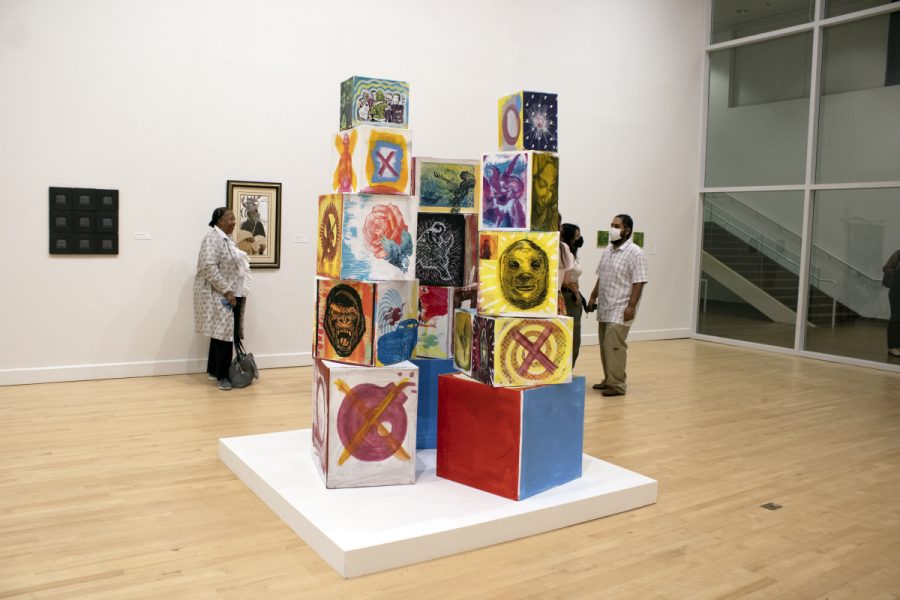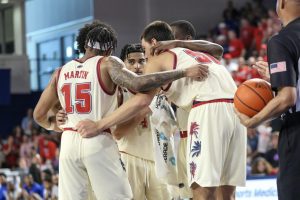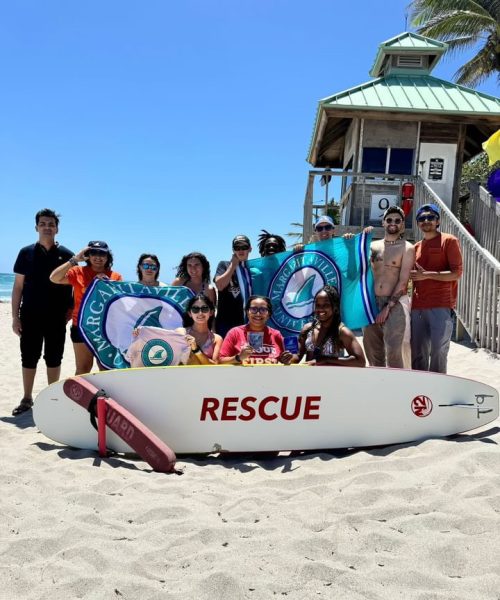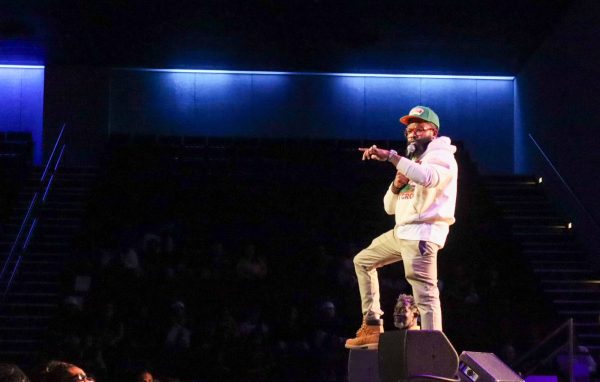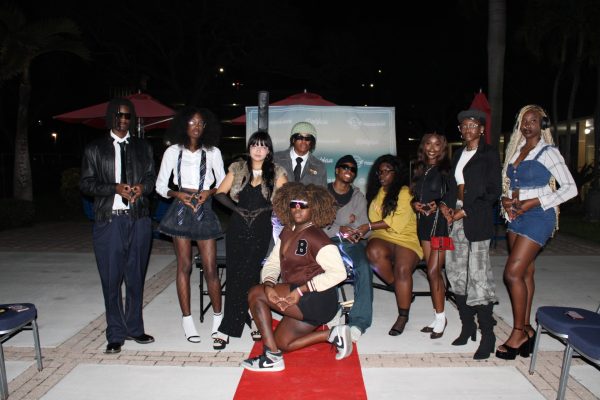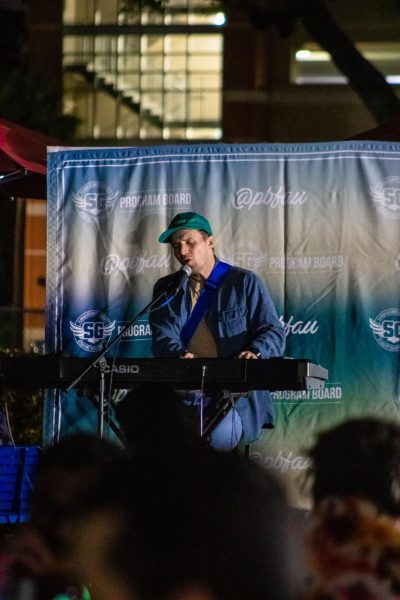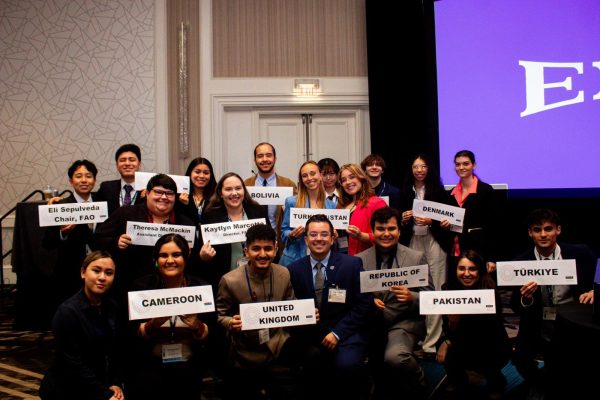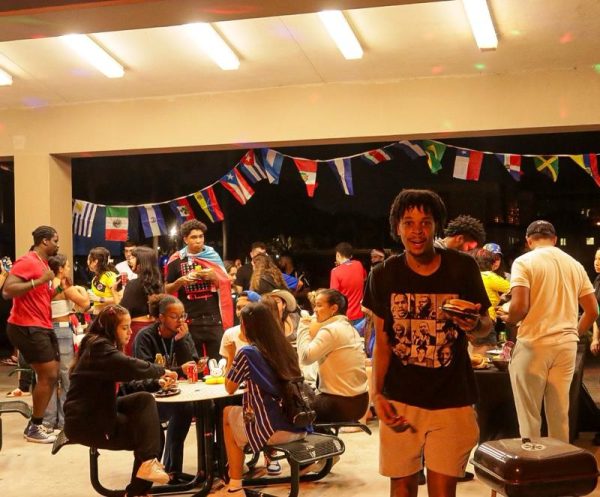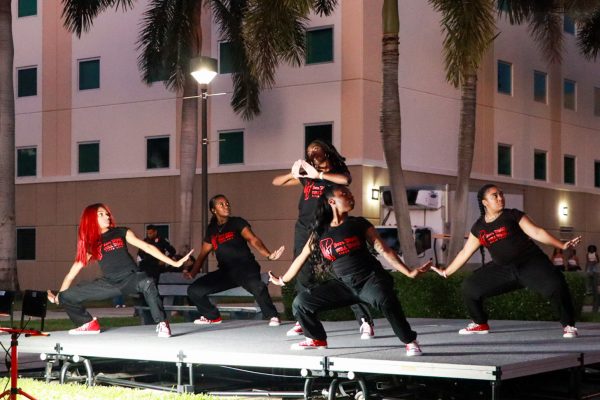Appreciate art at the 2021 Biennial Faculty Art Exhibition
Twenty-three faculty members display their creative skills, giving a glimpse of what FAU has to offer.
November 23, 2021
Kiara Wilson, a film major, walked slowly through the Schmidt Center Gallery allowing her eyes to pass over the sculptures, photographs, and paintings on display at this year’s “Biennial Faculty Art Exhibition.” She stopped to examine a ceramic sculpture on a pedestal, an abstract, pale-yellow mound covered in petal-like shapes.
“I know when I show my work and stuff, I get kind of nervous with all of that,” Wilson said. “I think maybe just seeing more shows would really get me more out there to do my own work and showcase it.”
The piece Wilson lingered on is part of a series created by Thomas Stollar, the assistant professor of ceramics at FAU. Titled “Up or Down,” the collection of works displayed are the most recent series of sculptures crafted by Stollar.
“I like it because part of my idea is [to] not be able to tell what the material is,” Stollar said. “What I do is build these things out of clay and then I pour resin on top of them. Then I try to use colors that don’t really look like clay, you know?”
The 2021 Biennial Faculty Art Exhibition features the work of 25 faculty members across several different departments, including the School of Communication and Multimedia Studies, the Department of Visual Arts and Art History, the School of Architecture, and the Harriet L. Wilkes Honors College.
The exhibition is open to anyone looking to experience culture as well as those interested in seeing what the FAU faculty has to offer as they further their work as professional artists.
Natalie Luong and Richard Rodriguez, co-curators of the 2021 Biennial Faculty Art Exhibition, spared no detail when setting up the viewing space for the event.
“Everything is visually appealing,” said Rodriguez, the manager of exhibition production.
Some of the changes made to the viewing space were drastic. Luong described how the co-curators changed the space to better display a projection piece created by Mehrdad Sedaghat-Beghbani, the assistant professor of graphic design.
“We literally built a room for him, a dark room,” said Luong. “We have high ceilings, a lot of natural light. Projections don’t really work well in the Schmidt, so we straight up built a room and painted it all black.”
Creating a pleasing space where the work would be displayed was important to the co-curators to forge a connection between the students and the faculty.
“Sometimes students have found [a] block and they don’t know what to do,” said Rodriguez. “This [exhibition] hopefully will inspire [the students], whether it’s print-making, photography, ceramics, and every other medium like radio and TV.”
Associate Professor of Visual Art Dorotha Lemeh expressed her appreciation for the co-curator’s work. “There’s something that’s pulling all of the work together,” said Lemeh. “I see similar colors running through the entire [display]. It’s probably due to the curators that organized this. I think it’s simply beautiful.”
Lemeh’s contribution to the exhibit, a collage entitled “Mask in the Spirit of Our Second Selves,” combines photography and painting.
“For me, it’s like what they used to call crazy quilts. African-Americans doing all these quilts that look kind of jazzy the way they put the materials and colors together,” said Lemeh. “It’s the same thing when I’m doing my collage pieces. I’m putting pieces together, transforming what people perceive into something else, into a different characterization.”
The artwork presented was not limited to traditional forms of presentation. Several of the pieces on display were created using digital mediums, like Sedaghat-Beghbani’s projection piece.
“It responds to your voice so you can design the image as you’re speaking,” said Emily Fenichel, associate professor of art history, as she described Sedaghat-Beghbani’s work. “[It] actually did blow me away, the sort of interactiveness is really great.”
Video and audio mediums were present among the works. Most evidently, a short film depicting the journey of a garbage truck traveling to the dump created by Julie Anne Ward, Associate Professor of Sculpture, was played beside digital prints of the truck.
“I started thinking about the truck as a sculptural object,” said Ward. “The two still images on the right side of the video are really looking at the dump truck as a sculpture, as a sculptural element.”
The video communicates themes of environmental damage and the destruction caused by human beings, juxtaposing images of pristine farmland against piles of garbage as the truck makes its journey.
Color composition also played a key role in the creation of some of the works by Head of Printmaking and Assistant Professor Joseph Velasquez, mentioning the palettes at play in his art.
“[I chose] a colorful color scheme that is often used within [the] Chicano culture,” explained Velasquez. “It’s typical of the palette that I use, where each color has a connection to an emotion of a season.”
Brian McConnell, professor of art history and classical archaeology, contributed several photographs of Mt. Etna taken during his recent sabbatical. Within the frames of the photos, Dr. McConnell included volcanic ash that collected on his balcony during his stay. “Every once in a while, the volcano will erupt,” said Dr. McConnell. “It’s part of your environment. It’s part of your aesthetic. It’s what you see.”
The exhibition features a variety of artwork, making it easy for anyone to find something to connect to. “It’s really lovely to see what my colleagues are getting up to,” said Fenichel. “To actually see what they work on is always mind-blowing to me.”
Anyone interested in visiting the exhibition can do so from Nov. 12, 2021 to Jan. 29, 2022.
Caroline Little is a contributing writer for the University Press. For information regarding this or other stories email her at [email protected]

